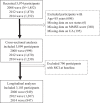High Blood Uric Acid Is Associated With Reduced Risks of Mild Cognitive Impairment Among Older Adults in China: A 9-Year Prospective Cohort Study
- PMID: 34720995
- PMCID: PMC8552040
- DOI: 10.3389/fnagi.2021.747686
High Blood Uric Acid Is Associated With Reduced Risks of Mild Cognitive Impairment Among Older Adults in China: A 9-Year Prospective Cohort Study
Abstract
Background: It remains unsolved that whether blood uric acid (UA) is a neuroprotective or neurotoxic agent. This study aimed to evaluate the longitudinal association of blood UA with mild cognitive impairment (MCI) among older adults in China. Methods: A total of 3,103 older adults (aged 65+ years) free of MCI at baseline were included from the Healthy Aging and Biomarkers Cohort Study (HABCS). Blood UA level was determined by the uricase colorimetry assay and analyzed as both continuous and categorical (by quartile) variables. Global cognition was assessed using the Mini-Mental State Examination four times between 2008 and 2017, with a score below 24 being considered as MCI. Cox proportional hazards models were used to examine the associations. Results: During a 9-year follow-up, 486 (15.7%) participants developed MCI. After adjustment for all covariates, higher UA had a dose-response association with a lower risk of MCI (all P for trend < 0.05). Participants in the highest UA quartile group had a reduced risk [hazard ratio (HR), 0.73; 95% (CI): 0.55-0.96] of MCI, compared with those in the lowest quartile group. The associations were still robust even when considering death as a competing risk. Subgroup analyses revealed that these associations were statistically significant in younger older adults (65-79 years) and those without hyperuricemia. Similar significant associations were observed when treating UA as a continuous variable. Conclusions: High blood UA level is associated with reduced risks of MCI among Chinese older adults, highlighting the potential of managing UA in daily life for maintaining late-life cognition.
Keywords: cognitive function; mild cognitive impairment; older adults; prospective cohort study; uric acid.
Copyright © 2021 Chen, Li, Lv, Yin, Zhao, Liu, Li, Ji, Zhou, Wei, Cao, Wang, Gu, Lu, Liu and Shi.
Conflict of interest statement
The authors declare that the research was conducted in the absence of any commercial or financial relationships that could be construed as a potential conflict of interest.
Figures



Similar articles
-
[Association of blood uric acid and cognitive impairment in oldest-old aged 80 years and older in 9 longevity areas of China].Zhonghua Yu Fang Yi Xue Za Zhi. 2021 Jan 6;55(1):39-44. doi: 10.3760/cma.j.cn112150-20200724-01053. Zhonghua Yu Fang Yi Xue Za Zhi. 2021. PMID: 33355767 Chinese.
-
A Prospective Study on the Association between Uric Acid and Cognitive Function among Middle-Aged and Older Chinese.J Alzheimers Dis. 2017;58(1):79-86. doi: 10.3233/JAD-161243. J Alzheimers Dis. 2017. PMID: 28387669
-
Uric acid index is a risk for mild cognitive impairment in type 2 diabetes.Hormones (Athens). 2023 Sep;22(3):425-439. doi: 10.1007/s42000-023-00465-3. Epub 2023 Jul 31. Hormones (Athens). 2023. PMID: 37523135
-
Longitudinal Association between Uric Acid and Incident Sarcopenia.Nutrients. 2023 Jul 11;15(14):3097. doi: 10.3390/nu15143097. Nutrients. 2023. PMID: 37513515 Free PMC article.
-
Hyperuricemia as a Protective Factor for Mild Cognitive Impairment in Non-Obese Elderly.Tohoku J Exp Med. 2017 May;242(1):37-42. doi: 10.1620/tjem.242.37. Tohoku J Exp Med. 2017. PMID: 28529242
Cited by
-
Mechanistic insights of soluble uric acid-induced insulin resistance: Insulin signaling and beyond.Rev Endocr Metab Disord. 2023 Apr;24(2):327-343. doi: 10.1007/s11154-023-09787-4. Epub 2023 Jan 30. Rev Endocr Metab Disord. 2023. PMID: 36715824 Review.
-
Diagnostic and prognostic implications of non-high-density lipoprotein cholesterol and homocysteine levels for cognitive impairment in thalamic infarction.World J Psychiatry. 2023 Dec 19;13(12):985-994. doi: 10.5498/wjp.v13.i12.985. eCollection 2023 Dec 19. World J Psychiatry. 2023. PMID: 38186727 Free PMC article.
-
Progression of cognitive impairment in Parkinson's disease correlates with uric acid concentration.Front Neurol. 2024 May 30;15:1378334. doi: 10.3389/fneur.2024.1378334. eCollection 2024. Front Neurol. 2024. PMID: 38872819 Free PMC article.
-
Non-Invasive Screening for Early Cognitive Impairment in Elderly Hyperuricaemic Men Using Transcranial Colour-Coded Duplex Sonography.Diagnostics (Basel). 2025 Jun 15;15(12):1519. doi: 10.3390/diagnostics15121519. Diagnostics (Basel). 2025. PMID: 40564841 Free PMC article.
-
Closing the gap in dementia research by community-based cohort studies in the Chinese population.Lancet Reg Health West Pac. 2025 Jan 21;55:101465. doi: 10.1016/j.lanwpc.2025.101465. eCollection 2025 Feb. Lancet Reg Health West Pac. 2025. PMID: 39902152 Free PMC article. Review.
References
LinkOut - more resources
Full Text Sources

